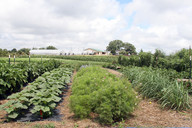
Request for Applications (RFA) Published for TEFAP Reach and Resiliency Grant Funding – Apply Now!
On December 6, 2021, FNS published a Request for Applications (RFA) on Grants.gov, outlining the processes that The Emergency Food Assistance Program (TEFAP) State agencies must follow in order to apply for Round 1 TEFAP Reach and Resiliency grant funding. TEFAP Reach and Resiliency grants are intended to expand TEFAP reach into remote, rural, Tribal, and/or low-income areas that are underserved by the program. At this time, $50 million in grant funding is being made available to TEFAP State agencies on a competitive basis.
Interested State agencies are invited to apply for the grant funding by submitting an application package in the Grants.gov web portal by February 4, 2022. That application package must include a project plan that details how the State agency will work with program stakeholders to achieve the objective of the grant program, among other application requirements outlined in the RFA.
TEFAP Reach and Resiliency grants are a key part of USDA’s larger Build Back Better initiative, which aims to improve access to nutritious food, provide resources to historically underserved and marginalized populations, better support producers and workers, and create a more resilient food system, among other goals. A second round of TEFAP Reach and Resiliency grants will be announced at a later date and will include an additional $50 million in funding plus any portion of round one funding that remains after initial projects are funded. FNS will apply lessons learned from the first round of funding to determine how best to target and allocate the second round of funding.
|
Local Food Purchase Assistance Cooperative Agreement Program
As part of the Build Back Better initiative, the USDA Agricultural Marketing Service (AMS) is establishing the Local Food Purchase Assistance Cooperative Agreement Program (LFPA). The program will award up to $400 million through non-competitive cooperative agreements with state and tribal governments. LFPA aims to support local, regional, and socially disadvantaged farmers and ranchers through the purchase of local foods for the emergency food assistance network. This program allows states and tribal governments to procure and distribute product grown within the state or within 400 miles of the delivery destination to support distribution of healthy, locally grown foods to remote, rural, and underserved communities. State and tribal governments are eligible to apply for cooperative agreements and applications must be submitted in Grants.gov by April 5, 2022.

Canned Spinach and Other Greens – Versatile and Nutritious
Canned kale and collard greens are two new temporary additions to the Commodity Supplemental Food Program (CSFP)! These canned leafy greens as well as canned spinach, which is a permanent item available in TEFAP and CSFP, pack a punch when it comes to nutrition. They are low in calories, high in vitamins A and C, offer a good source of calcium and fiber, and are naturally fat-free. They are also low in sodium and are always “in-season.” Canned greens are a real time saver in the kitchen – they do not need to be thawed or washed and can be easily used as a substitute for frozen or fresh greens. Canned greens can be transformed into a quick side dish. Simply drain and heat canned spinach, kale, or collard greens, then flavor with your favorite seasoning such as garlic or onion powder, cayenne pepper, vinegar, or lemon – the options are endless! Greens are also a great addition to soups, casseroles, and pasta dishes – drain a can and add it to your favorite meal. You can also substitute canned kale or collard greens in place of canned spinach and vice versa. Have leftovers from last night’s dinner? Prepared canned greens can be stored in the refrigerator in a container with a tight lid for a few days, or if you need more time, store them in the freezer in a plastic bag with a tight seal. Check out the canned spinach product information sheet and the SNAP Recipes at MyPlate Kitchen for dozens of recipes and tips!
|
Children Ages 5-11 Are Now Eligible for the COVID-19 Vaccine
All kids 5 and older are now eligible to get vaccinated. This is a safe and effective vaccine. It has undergone rigorous review, and now has been authorized by FDA and recommended by CDC for kids ages 5-11, after thorough testing for safety in thousands of children. We encourage USDA partner agencies to share the messaging below with program participants and parents.
The best way to protect your child against COVID-19, including the Delta variant, is to get them vaccinated.
- Kids are being infected with COVID-19, and some are getting seriously ill or even dying. Even if your child doesn’t get severely ill, they could face long-term health consequences or pass the virus to others.
- If your child gets COVID-19, the negative health effects can be serious and last months; but the most common side effect of the vaccine is a sore arm.
- We know that many parents are trying to decide what is right for their child and their family. If you have questions about your child and the COVID-19 vaccine, talk to a pediatrician, school nurse, or another trusted health care provider.
Finding a vaccine is easy, and getting vaccinated is free.
- The vaccine for kids is available in more than 20,000 sites across the country, including thousands of pediatricians and family doctors’ offices, pharmacies, community health centers, children’s hospitals, and community-based sites and schools.
- Parents will be able to find available vaccines at vaccines.gov or by contacting their health care provider or local pharmacy.
Vaccines help protect your child, your family, and your community.
- 15 million adolescents have already been vaccinated.
- The vaccines offer lasting protection to prevent your child from getting infected or, worse, having severe outcomes. The vaccine is more than 90% effective.
- Getting vaccinated will help keep schools open, sports going, and help our kids maintain a more normal lifestyle, thanks to the protection provided by the vaccines.

Fiscal Year 2022 Farm to Food Bank Project Funding has been awarded to 29 TEFAP State Agencies
In November, FNS awarded funding to 29 TEFAP State agencies for FY 2022 Farm to Food Bank Project. Of those projects, 22 include expansions or continued support for States who received funding in FY 2020 or FY 2021, and 7 are newly participating States. These projects include a variety of activities to rescue surplus agricultural products that would otherwise go to waste. The foods are distributed through food banks and partnering organizations to families in need. Summaries of states’ projects can be found here: https://www.fns.usda.gov/tefap/fy-2022-farm-food-bank-project-summaries
|

Expanded Home Delivery Partnerships Within CSFP
In order to remove barriers and increase enrollment in CSFP during the pandemic, some programs have expanded their home delivery partnerships. In Pennsylvania, Hunger-Free PA and the Pennsylvania Department of Agriculture (PDA), who administer CSFP in the State, utilized Link2Feed for the program, using a partnership with DoorDash to deliver CSFP packages. The pilot was first funded for six months, starting in July 2021, and after achieving success, was funded by DoorDash through Project DASH for Hunger-Free PA, Feeding Pennsylvania, and other local agencies through at least December 2022.
As an overview, seniors sign up for CSFP through the food bank and indicate their interest in DoorDash delivery, if it is available in their area. The food bank enters information for the senior into a DoorDash database – including their name, delivery address, date/time for delivery, and location for box pickup (sometimes it might be the main food bank, other times they may pick up from a pantry). Upon delivery, the senior or an approved proxy signs for the box and that information is transferred back to the food bank. Because of the system integration between Link2Feed and DoorDash, the information can then be uploaded into Link2Feed.
"DoorDash is proud to partner with Hunger-Free Pennsylvania, Feeding Pennsylvania, and others to power the delivery of food boxes to seniors through Project DASH," said Brittany Graunke, DoorDash Drive's Director of Government and Nonprofit. "Leveraging our last-mile logistics platform, we are committed to promoting convenience and dignity while reducing barriers to accessing meals, groceries, and pantry items."
If you are involved in administering at a State or local agency and have an innovative practice that you’d like us to feature, we encourage you to reach out to usdafoods@usda.gov.
|
How-To: Finding Policy Memoranda on fns.usda.gov
The fns.usda.gov webpage is a great resource for locating policy memoranda! To locate policy memoranda on fns.usda.gov, first, locate your program of choice from the "Programs" tab at the top of the screen. In this example, we will be locating a CSFP policy memo.
 After choosing the Commodity Supplemental Food Program from the Programs tab, near the bottom of the CSFP page, we see the following selections for Policy:
 This will take you to the CSFP Documents and Resources page, filtered by Policy Memos. From here, you can use key word searches for individual memos, use the filters to switch between resource types, or sort by newest/oldest, among other options. You can follow the directions in the same way to access policy memos for TEFAP.
Direct Link to CSFP Policy Memos
Direct Link to TEFAP Policy Memos

CSFP Vegetable Issuance Rate Increase!
Since 2020, CSFP has been experiencing an ongoing canned vegetable shortage. We are excited to share that CSFP vegetable inventories have improved nationwide. Accordingly, on November 1, 2021, FNS released an updated CSFP Guide Rate to temporarily increase the quantity of vegetables offered in the CSFP Maximum Monthly Distribution Rates from 4 units to 6 units. This change is effective immediately until inventories can be replenished. Nationwide inventories do not support moving to 8 units of vegetables yet, but USDA continues to work to alleviate shortages to move back to the full eight-unit issuance as soon as possible.
We appreciate everyone’s understanding as we work to ensure CSFP participants continue to receive critical food assistance during this time. To view the full memorandum, please click here.
|

Temporary Vegetables Purchased for CSFP Vegetable Shortage
The Commodity Supplemental Food Program (CSFP) is currently experiencing a vegetable product shortage due to ongoing issues with vendors’ ability to supply canned vegetables. To help address this issue, FNS is temporarily purchasing new types of vegetables for CSFP. USDA created a one pager, "Temporary Vegetables Purchased for CSFP Vegetable Shortage," to provide some information on what those vegetables are and how to use existing product information sheets to provide recipes and related information to clients to help them use these products. The one pager was sent to States in October. Please contact your Regional Office if you have any questions.
|
Browser Change for WBSCM Coming in 2022
The Web-based Supply Chain Management (WBSCM) system will be transitioning to the Google Chrome browser for access to the WBSCM Portal in Spring 2022. Microsoft has announced that they will end support for Internet Explorer 11 for Windows, and Federal security guidelines require agencies to replace system components when support is no longer available.
All users are encouraged to begin using Chrome for activities in WBSCM. Please report any issues or challenges to the WBSCM Service Desk so they can be recorded and tracked for further analysis and testing to prepare for the official transition to Chrome.
For questions about WBSCM, please contact the WBSCM Service Desk or call (877) 927-2648.
|